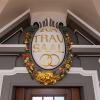Do you want to exchange your notes of 5 and 25 guilders? Then you have until Thursday
/s3/static.nrc.nl/images/gn4/data131350338-d33d38.jpg)
This Wednesday is the very last day that people get something back for their ‘Vondel’ or their ‘Swee-Linck’. A Vondel yields 2.27 euros until that day, a Sweelinck even 11.34 euros. Joost van den Vondel and Jan Pieterszoon Sweelinck are two of the originally five heirs who adorned the Guldennorettes in the last century. Vondel borrowed his tronie stylized by designer Oxenaar on the five -guilder note, Sweelinck adorned that of 25 guilders. Both notes, since the introduction of the euro in 2002 no longer suitable as a payment method, can be returned to De Nederlandsche Bank (DNB) until 1 May this year at the latest. Then the legal period of thirty years that DNB uses for the handing in old notes will expire. After that, the custody of the payment transactions does not give anything in return.
It is the second time since the euro that a Goldennote loses its value definitively. The last time, in July 2016, it was a 100 -guilder note with the image of another testator, Michiel de Ruyter. The last day-in-day for that Coupure was 25 July 2016, exactly thirty years after De Ruyter was replaced by the snip (and later the owl), the later 100 guilds notes.
So on 1 May it is Vondel and Sweelinck’s turn. At De Nederlandsche Bank they have been working on the return theadline for months, says Head of Cash Management Rob Pijpers on the phone. « Since we stated on the website at the beginning of January that the end date for these two notes is approaching, it is busy. » In fact, it concerns three notes: Van Vondel was published a new version after the original series from 1966 in 1976.
Notes contain micro-plastics and metals, you can’t just throw them away
Both Vondel notes were replaced by a five-guilder coin on 1 May 1995. The Sweelinck notes were replaced by the robin in the 1990s and were also ‘put out of circulation’ on 1 May 1995, as it is called. All other guilders notes (lighthouses, sunflowers, lapwing, snipping and owls) remained in circulation until the arrival of the euro on January 1, 2002. For those denominations, January 1, 2032, therefore, the extreme submission date, thirty years after the introduction of the euro.
Extra questions
Around sixty people call the DNB call center every day to register their notes. Because passing by spontaneously on the Frederiks square is not there. Anyone who has something to hand in, must register that in writing in advance, Via the bank’s website. Then we look at how the money can best be returned: via the mail (in the case of smaller amounts, at the risk of the sender) or at the counter. In appropriate cases, DNB can also ask additional questions about the origin of the notes, says Pijpers: « It is now mainly about small amounts, but as a supervisor we also have a task in preventing money laundering. So if a request for submitting Gulden notes raises questions, we must request extra information about it. »
Pijpers says that it is not only the Vondels and Sweelincks that are handed in, but all still present guilder notes. « That’s how it often works: you will find a stack of Gulden notes somewhere, for example at the death of your parents and the emptying of a house, and then you hand it in in one go. » Since the first call in early January, DNB received 3,900 notes of five guilders and 4,200 notes of 25 guilders. About 16,000 notes came in from other denominations, so double.
That is, incidentally, a pittance of the number of guilder notes that is still in circulation. In total, DNB estimates, there would still be 34 million guilder notes, with a total value of 425 million euros. Nine million of them are Vondels, three million Sweelincks.
In total, DNB, there would be 34 million guilder notes, with a total value of 425 million euros
DNB does its best to handle submitted notes as quickly as possible and to transfer the amount due in euros to the owners. That still happens along the 2,20371-Omgactor factor from euros to guilders (one euro for 2,20371 guilders, therefore). Anyone who has been registered before 1 May will still receive his money, even if the actual delivery will take place later.
Artworks
As soon as the money within the walls of the central bank is, it loses its value. After all, it is no longer in circulation. And so everything is destroyed. When the euro was introduced in 2002, DNB received huge amounts of Dutch bills in one fell swoop, millions of notes. That was neatly sorted by ticket and then fragmented. DNB had Van de Bergen notes made of artworks, which were initially at the Bank’s head office on Frederiksplein in Amsterdam, but are now in the new Cash Center in Zeist, says Pijpers.
The Gulden notes that can be handed in until 1 May also disappear into the fragmenter. But there are so few that they ‘just’ go along with us in the stack of euro notes that have to be destroyed daily due to damage. DNB also no longer makes works of art from the fragmented money: « The rules for waste processing have been tightened. Notes contain micro-plastics and metals, you can’t just throw them away. Everything that is fragmented goes to a waste processor, » says Pijpers.
How many guilder notes will never return to De Nederlandsche Bank, dares not to say pipers. The fact is that the Dutch money was seen as the most beautiful money in the world. Designers Ootje Oxenaar and Jaap Drupsteen were praised internationally. In this way, the old notes keep something of nostalgic and cultural -historical value: as a reminder of the time that cash was still settled at all. With crackling, beautiful guilder notes.

:format(webp)/s3/static.nrc.nl/wp-content/uploads/2025/04/04111243/data130287438-072114.jpg)
:format(jpeg):fill(f8f8f8,true)/s3/static.nrc.nl/images/gn4/stripped/data133624369-1d45bc.png)
/s3/static.nrc.nl/images/gn4/stripped/data133730710-f91ee5.jpg|https://images.nrc.nl/VnTAZ7_LDIaNNWLMN_C8ZsbQkS4=/1920x/filters:no_upscale()/s3/static.nrc.nl/images/gn4/stripped/data133730710-f91ee5.jpg|https://images.nrc.nl/8CZi9MsLkc6P5MD4yDxEZm0syjQ=/5760x/filters:no_upscale()/s3/static.nrc.nl/images/gn4/stripped/data133730710-f91ee5.jpg)


